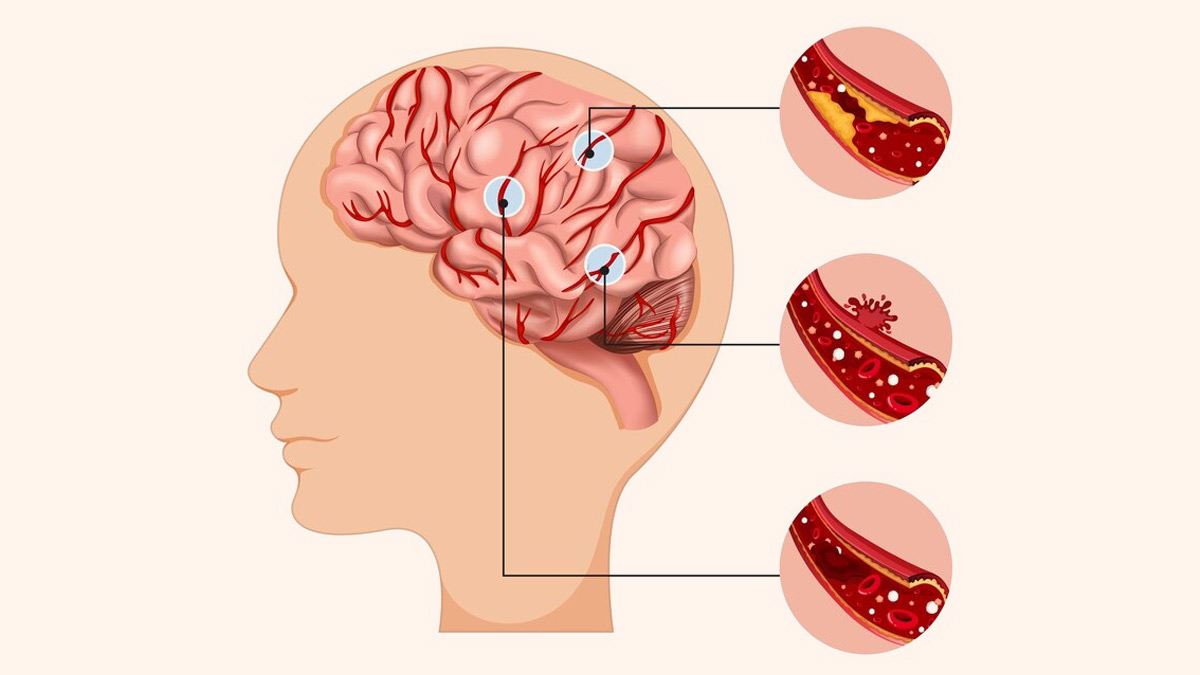Brain Stroke
Brain Stroke also called Cerebrovascular Accident ( CVA )is the damage to the brain or brain cells and tissues from interruption of its blood supply. A stroke is a cerebrovascular accident. This functional abnormality of the CNS occurs when the blood supply to the brain is disrupted. Like other organs, the brain also needs oxygen and nutrients provided by blood to function properly. If the supply of blood to the brain is stopped, brain cells begin to die. This can lead to brain damage or death
Types of Stroke:
There are two types of stroke
-
Hemorrhagic
( 13% of blood vessels are ruptured) -
Ischaemic
(Also known as Brain Attack. 87% vascular occlusion circle of Willis and hypo-perfusion)
Causes of Brain Stroke:
- Thrombosis: blood clot in the blood vessels of the brain or neck
- Cerebral embolism
- Ischemia
- Vascular Compression
- Vascular spasm
- Cerebral hemorrhage
Risk Factors:
- Hypertension
- Diabetes mellitus
- Cigarette smoking
- Obesity
- High cholesterol
- Previous transient attack
- Family history of stroke
- Atherosclerosis
- Congestive heart failure
- Drink Alcohol and use cocaine
- KidnCeliac Diseaseey disease
Symptoms and clinical manifestation of Brain Stroke:
- Numbness and weakness in Arm, Face and Legs
- Paralysis in the face, arms, and legs
- Severe headache
- Loss of memory
- Swallowing difficulty
- Loss of vision on one or both sides
- Loss of body balance or coordination
- Loss of sensation and speaking difficulty
- Visual disturbance
Diagnosis of Brain Stroke:
- History collection
- Physical examination
- CT Scan
- MRI
- Angiography
- PET- Positron Emission
- Tomography
- Enchoencephalography
- Laboratory studies
- Carotid Doppler Ultrasound
Medication:
- Thrombolytic agents
- Anticoagulant (Heparin)
- Antiplatelets
- Mild analgesic- Ibuprofen
- Steroids-(Anti-inflammatory)
- Anti-hypersensitive ( Verapamil)
Surgical Management:
- Evacuation of hematoma
- Carotid endarterectomy ( removal of material on the inside of an artery)
FAQs:
- Q: What is a stroke?
- A stroke, or cerebrovascular accident (CVA), is a sudden interruption of blood supply to the brain, resulting in damage to brain cells. This can happen either due to a blockage in the blood vessels (ischemic stroke) or bleeding in the brain (hemorrhagic stroke).
- Q: What are the common signs and symptoms of a stroke?
- A: Common signs include sudden numbness or weakness in the face, arm, or leg, especially on one side of the body; sudden confusion, trouble speaking, or difficulty understanding speech; sudden trouble seeing in one or both eyes; and sudden severe headache with no known cause.
- Q: What should I do if I suspect someone is having a stroke?
- A: Act FAST! F – Face: Ask the person to smile. Does one side of the face droop? A-Arms: Ask the person to raise both arms. Does one arm drift downward? S – Speech: Ask the person to repeat a simple phrase. Is their speech slurred or strange? T – Time: If you observe any of these signs, call emergency services immediately.
- Q: What are the risk factors for stroke?
- A: Common risk factors include high blood pressure, smoking, diabetes, high cholesterol, obesity, and a family history of stroke. Age, gender, and race also play a role.
- Q: Can strokes be prevented?
- A: Yes, many strokes can be prevented by managing and controlling risk factors. This includes maintaining a healthy lifestyle, regular exercise, a balanced diet, controlling blood pressure, and not smoking.
- Q: How is a stroke diagnosed?
- A: Diagnosis typically involves a physical examination, imaging tests (such as CT or MRI scans), and blood tests. These help determine the type of stroke and its severity.
- Q: What is the treatment for a stroke?
- A: The treatment depends on the type of stroke. Ischemic strokes may be treated with medications like clot-busting drugs, while hemorrhagic strokes may require surgery to repair bleeding blood vessels. Rehabilitation and therapy are often crucial for recovery.
- Q: What is the recovery process like after a stroke?
- A: Recovery varies for each individual. Physical therapy, occupational therapy, and speech therapy are often part of the rehabilitation process. The extent of recovery depends on factors like the severity of the stroke and promptness of treatment.
- Q: Can a person have more than one stroke?
- A: Yes, individuals who have had a stroke are at an increased risk of having another. It’s crucial to manage risk factors and follow medical advice to reduce the likelihood of recurrent strokes.
- Q: Is there ongoing research for stroke treatment and prevention?
- A: Yes, research in stroke treatment and prevention is ongoing. Scientists are exploring new therapies, medications, and interventions to improve outcomes and reduce the impact of strokes.




[…] of Cardiovascular Disease: High blood pressure (hypertension) is a major risk factor for cardiovascular diseases such as heart attack, stroke, and heart […]
[…] Tension or a pulling force […]
[…] Swallowing difficulty […]
[…] type of meningitis may present with similar symptoms, including headache, fever, stiff neck, sensitivity to light, and altered mental status, but the treatment can vary […]
[…] depends on the type of heart block. Healthcare providers will administer medication to address conditions such […]